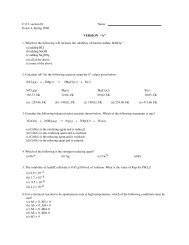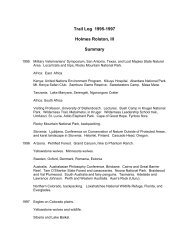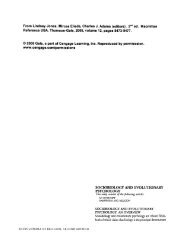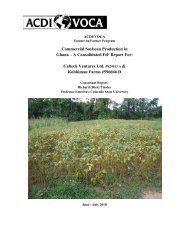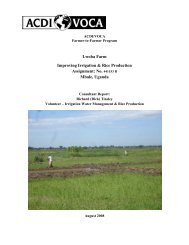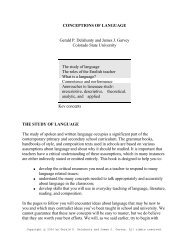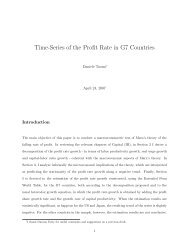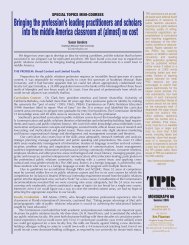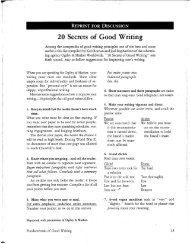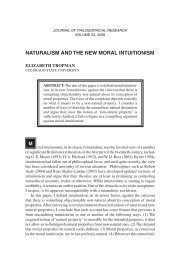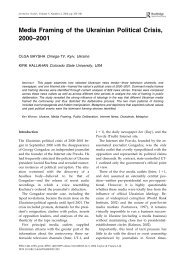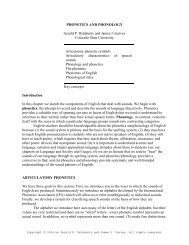Geha Foods Evaluation of Irrigation for Processed Tomatoes
Geha Foods Evaluation of Irrigation for Processed Tomatoes
Geha Foods Evaluation of Irrigation for Processed Tomatoes
Create successful ePaper yourself
Turn your PDF publications into a flip-book with our unique Google optimized e-Paper software.
Too <strong>of</strong>ten the interpretation is either “a” or “b”, lack <strong>of</strong> knowledge or lack <strong>of</strong> concern.<br />
However, more <strong>of</strong>ten than not, in this consultant experience, it has been “c” lack <strong>of</strong> means,<br />
and the emphasis on “a” and “b” at the expense <strong>of</strong> “c” has been major reason <strong>for</strong> the limited<br />
effectiveness <strong>of</strong> total agriculture development ef<strong>for</strong>t over the past 40 years. How you<br />
approach improving the irrigation system or other agriculture activity varies tremendously<br />
depending on which <strong>of</strong> these choices is assumed and which is actually correct. In the first<br />
two cases the need is to emphasize knowledge, education and motivation, while in the latest<br />
case it is facilitation and enhancing the resources available to the farmers to do what they<br />
already knows needs to be done. Mistaking “a” and “b” <strong>for</strong> “c” can not only result in an<br />
ineffective ef<strong>for</strong>t, but can be somewhat antagonistic to sensitive recipients as it implies<br />
considerably less competence than they may actually posses.<br />
When the farm chairmen in the last field visit could accurately tell the elevation drop down<br />
the furrows and acknowledge the importance <strong>of</strong> leveling, but claim that it has not been done<br />
since Soviet time, I think “lack <strong>of</strong> means” could be the major problem. Certainly, if he is<br />
leveraged to produce cotton with uneconomic returns, the lack <strong>of</strong> means to fully maintain the<br />
on-farm irrigation system is very real. It has to be a legitimate second priority to wages <strong>for</strong><br />
the farm families. If this is the case, <strong>Geha</strong> <strong>Foods</strong> can provide some valued assistance to the<br />
farms by working with the various chairmen and implementing irrigation improvements as<br />
fields are rotated into tomato production, and mostly following the desires <strong>of</strong> the farm<br />
chairman <strong>for</strong> what he sees as needing to be done. From the political perspective <strong>of</strong> obtaining<br />
the cooperation needed <strong>for</strong> tomato production, it is really the only option.<br />
Brief Description <strong>Irrigation</strong> in Tajikistan<br />
Field Applications: The current irrigation system in Tajikistan is a surface system that<br />
appears developed primarily <strong>for</strong> large State Farms, with their excessive labor supply. It thus<br />
appears more like the systems I have seen serving smallholder communities than those<br />
serving large farms. This has resulted in the water flows that appear subdivided to the extent<br />
the water can be manually shifted to individual furrows or small groups <strong>of</strong> furrows (Fig. 5),<br />
rather then large 20 ha surface irrigation sets common in Eastern Colorado. Such limited<br />
flows result in substantial conveyance losses in the system most <strong>of</strong> which will leach to the<br />
water table and eventually return to the rivers. Also, the irrigation furrows tend to run<br />
directly down the slopes instead <strong>of</strong> along the contour with slopes <strong>of</strong> up to an estimated 3%<br />
(Fig. 6). This is too steep <strong>of</strong> non-critical (laminar) flow resulting in turbulent flow and<br />
noticeable erosion in the furrows, some <strong>of</strong> it approaching 30 cm <strong>of</strong> erosive cut. To some<br />
extent the erosion is minimized by allowing very low flows to enter the furrow, perhaps as<br />
low as 0.25 l/s instead <strong>of</strong> the 1 l/s or more usually needed to push a wetting front expediently<br />
to the end <strong>of</strong> a furrow. Furthermore, the furrows are not uni<strong>for</strong>m in grade and will have one<br />
or two benches down the furrow that will slow the flow, deposit some suspended sediment,<br />
and possibly breech between furrows, be<strong>for</strong>e continuing to the end <strong>of</strong> the furrow (Fig. 7).<br />
The actual flows into the individual furrows are <strong>of</strong>ten insufficient to reach the end and the<br />
irrigation physically stalls, preventing the lower end from receiving any water. <strong>Irrigation</strong><br />
stalls occur because as water flows down a furrow or basin the wetted surface continually<br />
increases as does the rate <strong>of</strong> water infiltration (Fig. 7). If the rate <strong>of</strong> infiltration exceeds the<br />
rate water enters the furrow no further advance is possible and the irrigation stalls. It also<br />
results in increasing the opportunity time <strong>for</strong> water to infiltrate and thus increases the<br />
7



